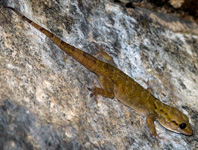Abstract
The Painted Rice Frog, Microhyla picta Schenkel, is one of the least studied species among narrow-mouthed frogs of the genus Microhyla. To date it is known only from Vietnam, where it is distributed mostly in eastern coastal areas in central and southern parts of the country (Nguyen et al. 2009; Nguyen & Hoang 2013). The species was also found in Con Dao archipelago (Poyarkov & Vassilieva 2011). No data are available on the ecology and reproductive biology of the species, and its larval morphology is also not described. Microhyla frogs are widespread and numerous in terrestrial ecosystems and microhylid tadpoles are known to play an important role in the aquatic communities of temporary waterbodies of monsoon ecosystems in Southeast Asia (Heyer 1973; Vassilieva et al. 2017). The ability to identify microhylid tadpoles in the field is pertinent for biodiversity and ecological studies. We provide a description of larvae of M. picta from various areas in southern Vietnam.
References
Altig, R. (2007) A primer for the morphology of anuran tadpoles. Herpetological Conservation and Biology, 2, 71–74.
Bourret, R. (1942) Les Batraciens de l' Indochine. Institut Océanographique de l' Indochine, Hanoi, 547 pp.
Chou, W.-H. & Lin, J.-Y. (1997) Tadpoles of Taiwan. Special Publication of the National Museum of Natural Science, Taichung, 7, 1–98.
Gosner, K.L. (1960) A simplified table for staging anuran embryos and larvae. Herpetologica, 16, 183–190.
Hendrix, R., Gawor, A., Vences, M. & Ziegler, T. (2008) The tadpole of the Narrow-mouthed Frog Microhyla fissipes from Vietnam (Anura: Microhylidae). Zootaxa, 1675, 67–68.
Heyer, W.R. (1973) Ecological interactions of frog larvae at a seasonal tropical location in Thailand. Journal of Herpetology, 7, 337–361.
https://doi.org/10.2307/1562868Inthara, C., Lauhachinda, V., Nabhitabhata, J., Chuaynkern, Y. & Kumtong, P. (2005) Mouth part structures and distribution of some tadpoles from Thailand. The Thailand Natural History Museum Journal, 1, 55–78.
Nguyen, N.H. & Hoang, M.D. (2013) The species composition of Amphibian and Reptile in Binh Chau—Phuoc Buu Nature Reserve, Ba Ria Vung Tau Province. In: Proceedings of the 5th National Conference on Ecology and Biological Resources. Agriculture Publishing House, Hanoi, pp. 504–513.
Nguyen, V.S., Ho, T.C. & Nguyen, Q.T. (2009) Herpetofauna of Vietnam. Edition Chimaira, Frankfurt am Main, 768 pp.
Poyarkov, N.A. & Vassilieva, A.B. (2011) Herpetodiversity of the Con Dao archipelago and a provisional list of amphibians and reptiles of Con Dao national park (Ba Ria—Vung Tau province, Vietnam). In: Proceedings of the 4rd National Conference on Ecology and Biological Resources. Agriculture Publishing House, Hanoi, pp. 286–293.
Vassilieva, A.B., Sinev, A.Y. & Tiunov, A.V. (2017) Trophic segregation of anuran larvae in two temporary tropical ponds in southern Vietnam. Herpetological Journal, 27, 217–229.
Yuan, Z.-Y., Suwannapoom, C., Yan, F., Poyarkov, N.A. Jr., Nguyen, N.S., Siriwadee, C., Murphy, R., Zhang, Y.-P. & Che, J. (2016) Red River barrier and Pleistocene climatic fluctuations shaped the genetic structure of Microhyla fissipes complex (Anura: Microhylidae) in southern China and Indochina. Current Zoology, 62, 531–543.
https://doi.org/10.1093/cz/zow042

